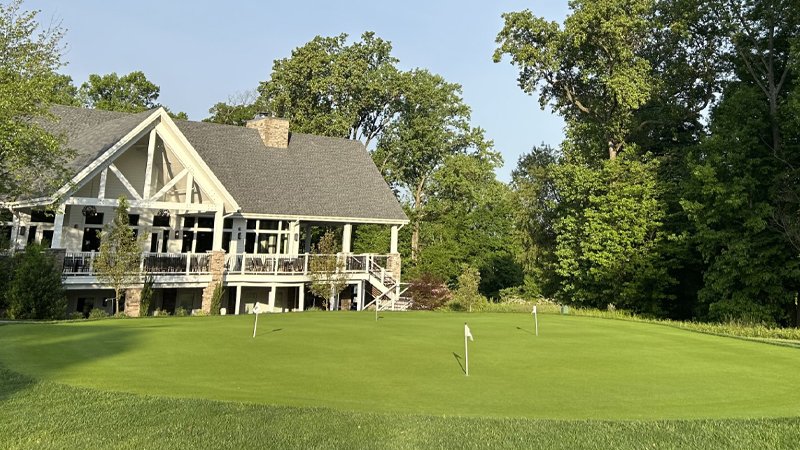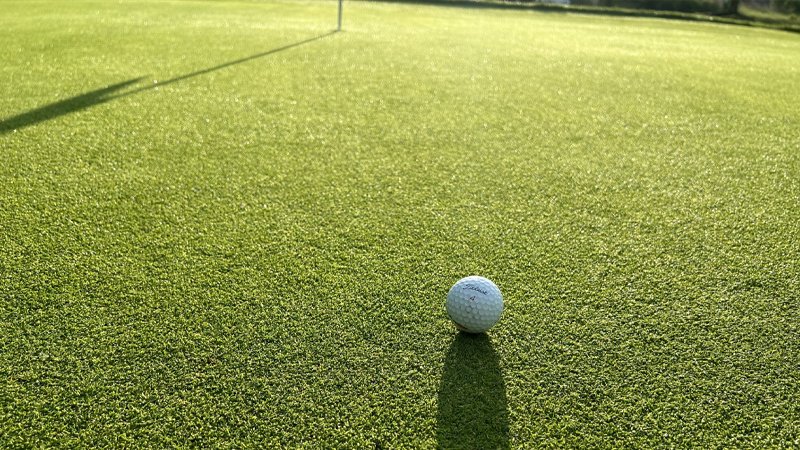"To lose patience is to lose the battle."
— Mahatma Gandhi
 When it comes to developing new turfgrasses, no one can accuse David Huff, Ph.D., (right) of being impatient.
When it comes to developing new turfgrasses, no one can accuse David Huff, Ph.D., (right) of being impatient.
Charged with developing cutting-edge solutions for the turf industry when he was hired as a plant breeder at Penn State in 1994, Huff has been patiently working toward that goal of delivering something innovative to help his constituents.
Huff has spent most of the past 30 years developing PA-33, the first commercially available seeded variety of Poa annua that has been tested on Penn State test plots as well as a handful of golf courses nationwide. Huff recently harvested the seed and is preparing it for sale later this year. Seed production, naturally, will be limited in the short term, said Huff who anticipates having 350-400 pounds for sale. Production could ramp up in the future if the endeavor is a commercial success, he said.
The cost of production is about $100 per pound of seed. Although he still is calculating the final sale price, Huff said superintendents should expect something in the neighborhood of $625 for a 5-pound bag, which is a fraction of the cost of sod. A total of 10 pounds of seed is enough to cover an average 5,000-square-foot putting green, he said.
PA-33, Huff says, is a high shoot density, dwarf perennial variety that is more tolerant to disease, heat and drought stress, is quick to germinate and provides coverage within about 21 days.
More cost effective than sod, but slower to establish, PA-33 has a promising place in golf, say superintendents who have managed it during Huff's research phase.

"I think that's the debate," said John Slade, superintendent at Laurel Creek Country Club in Mount Laurel, New Jersey. "If you're doing a greens renovation, you can buy sod and the course open more quickly, but you also have the option of seeding.
"If you have to do one or two greens, I think this will be the way to go."
Developing a seeded Poa was not first on Huff's list when he came to Penn State.
"I came in with a few ideas, like Kentucky bluegrass for fairways," Huff said. "People in the industry said to me: 'What else do you have?'
"If you look at the golf industry, Poa annua is a big part of it, but you couldn't buy seed for renovations."
Huff did not believe it was possible to improve upon the Penn A and G series developed by his predecessor, Joe Duich, Ph.D., so he focused his efforts elsewhere.
The aggressiveness and preponderance of so many bio-types of Poa annua led Huff to believe there was a place for a greens quality seeded variety.
At first I had a teaspoon full. Then I got an envelope full, then a bag, then a bigger bag. But I was losing the high shoot perennial nature I was looking for. It wants to become a seed-producing annual.
"Poa annua is a nice grass, but there are so many types it gets bumpy," he said. "If you have a uniform variety, you won't have that problem."
He set out collecting Poa samples from golf courses coast to coast.
"I started selecting and collecting samples in 1994," he said. "I was like a baseball scout, getting the best samples locally and from around the country."
He collected several samples, whittling down the list until he had a dozen of the best performers under stressful conditions.
Throughout the breeding process, one of his goals was to increase seed production without compromising the traits that make Poa annua such a good putting surface.
"At first I had a teaspoon full," he said. "Then I got an envelope full, then a bag, then a bigger bag. But I was losing the high shoot perennial nature I was looking for. It wants to become a seed-producing annual."
Huff was not the first to explore development of a high-quality variety of seeded Poa annua. He found evidence of others' work in the field, including in the 1950s at UCLA, while other work was conducted at the University of Rhode Island. The most, however, was done at the University of Minnesota, where some varieties were released, but as seed production ramped up they reverted to what Huff described as a "wild, weedy annual type."

During the past 30 years of research, Huff learned a great deal about the habits of Poa annua, namely that it has transgenerational memory and is capable of "remembering" how it is mowed and where the seed was grown, traits that actually become embedded in the plant's DNA, which Huff says "violates the rules of genetics."
"That's probably present in other turf species," Huff said. "It is so pronounced in Poa. That's its main operating system."
PA-33 thrives under aggressive management, and superintendents should resist the temptation to manage it like a seeded bentgrass. Huff says his research has shown that seed production decreases the more PA-33 is mowed.
"You really have to jump on it early. It thrives on that," Huff said.
"The father (Poa supina) can't tolerate mowing below a tenth-of-an-inch. The mother (Poa infirma) can't tolerate mowing. Together, they can tolerate low mowing below a tenth-of-an-inch. I know it's counter intuitive. That's a head-scratcher."
Brian Stiehler, superintendent at Highlands Country Club in Highlands, North Carolina, was one of five test sites around the country and had been growing PA-33 on his club's nursery. Recently he plowed up the nursery, not because of PA-33's performance, but because members at the club are wed to creeping bentgrass.
"My nursery has always been an experimentation place," Stiehler said. "There has always been some Penn A4 on it. But seven or eight years ago, I gridded out the nursery with the most popular bentgrasses. It was like my own NTEP trial. I wanted to see what was the best bentgrass in case we ever redid our greens.
"He developed the first harvested Poa seed, and asked if I would do a plot at Highlands. It did really well."
You really have to jump on it early. It thrives on that.
The greens at Laurel Creek have not been rebuilt since the club opened in 1989. Initially grassed with PennLinks creeping bentgrass, the greens today are a bent/Poa mix.
In the fall of 2022, a mix of Coho creeping bentgrass and PA-33 was seeded into Laurel Creek's new practice green as well as the practice range. He opted to mix the two varieties in an attempt to mimic conditions throughout the rest of the course.
The quote he received for sod shipped from Pittsburgh came in at $20,000, making the choice of Huff's new variety an easy one.
"We've spent the past year getting it down to height," Slade said. "The height of cut is down to match the rest of the golf course (at 0.100).
"What I want to see is if it will decrease in seed production over time. We're not seeing that yet."


